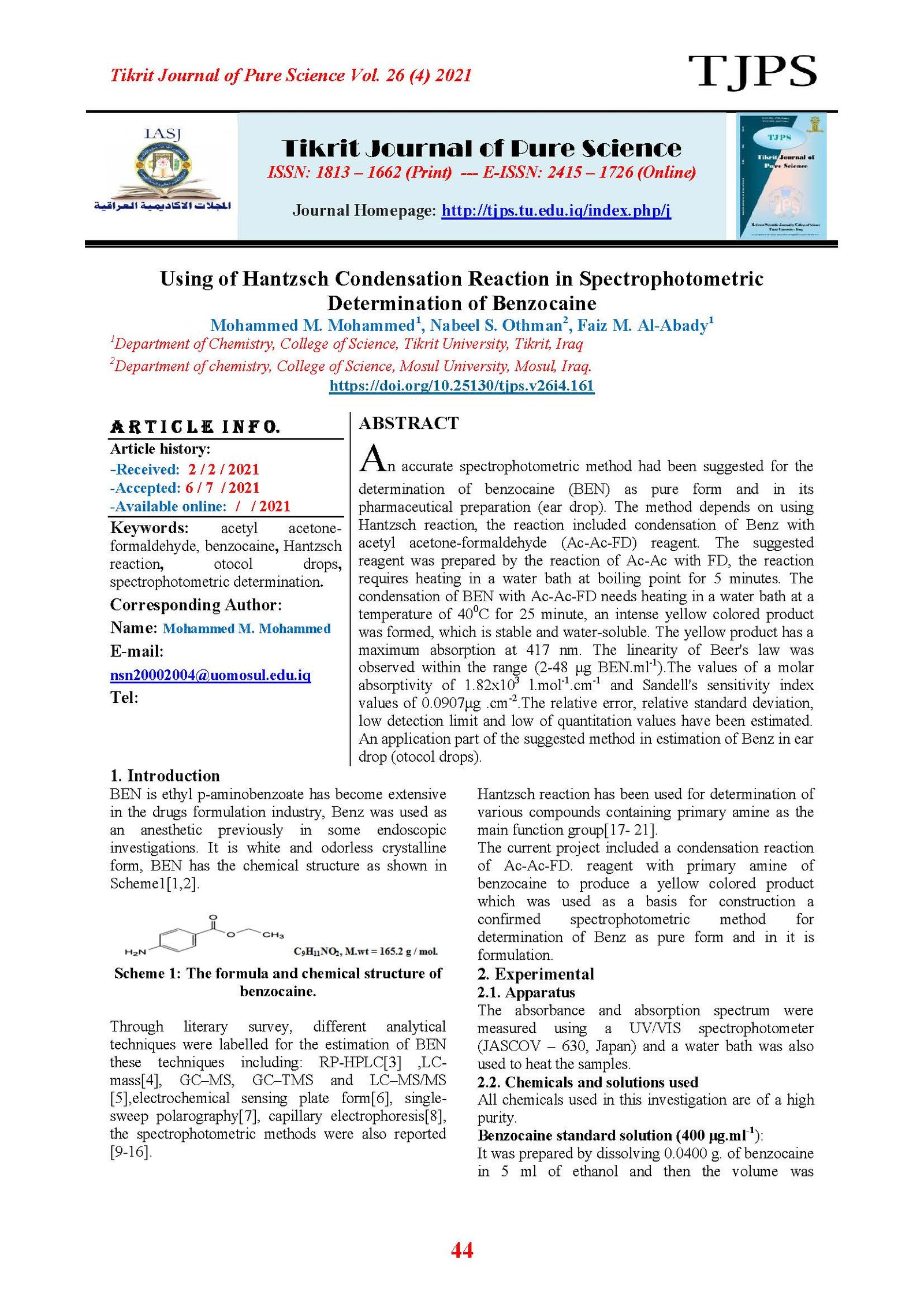Using of Hantzsch Condensation Reaction in Spectrophotometric Determination of Benzocaine
Main Article Content
Abstract
An accurate spectrophotometric method had been suggested for the determination of benzocaine (BEN) as pure form and in its pharmaceutical preparation (ear drop). The method depends on using Hantzsch reaction, the reaction included condensation of Benz with acetyl acetone-formaldehyde (Ac-Ac-FD) reagent. The suggested reagent was prepared by the reaction of Ac-Ac with FD, the reaction requires heating in a water bath at boiling point for 5 minutes. The condensation of BEN with Ac-Ac-FD needs heating in a water bath at a temperature of 400C for 25 minute, an intense yellow colored product was formed, which is stable and water-soluble. The yellow product has a maximum absorption at 417 nm. The linearity of Beer's law was observed within the range (2-48 μg BEN.ml-1).The values of a molar absorptivity of 1.82x103 l.mol-1.cm-1 and Sandell's sensitivity index values of 0.0907μg .cm-2.The relative error, relative standard deviation, low detection limit and low of quantitation values have been estimated. An application part of the suggested method in estimation of Benz in ear drop (otocol drops).
Article Details

This work is licensed under a Creative Commons Attribution 4.0 International License.
Tikrit Journal of Pure Science is licensed under the Creative Commons Attribution 4.0 International License, which allows users to copy, create extracts, abstracts, and new works from the article, alter and revise the article, and make commercial use of the article (including reuse and/or resale of the article by commercial entities), provided the user gives appropriate credit (with a link to the formal publication through the relevant DOI), provides a link to the license, indicates if changes were made, and the licensor is not represented as endorsing the use made of the work. The authors hold the copyright for their published work on the Tikrit J. Pure Sci. website, while Tikrit J. Pure Sci. is responsible for appreciate citation of their work, which is released under CC-BY-4.0, enabling the unrestricted use, distribution, and reproduction of an article in any medium, provided that the original work is properly cited.
References
[1] Benzocaine (Benzocainum). (2016). The International Pharmacopoeia, "Benzocaine",
https://www.who.int/medicines/publications/pharmacopoeia/Benzocaine.pdf?ua=1. 6, 1.
[2] British Pharmacopeia on CD-ROM. System Simulation Ltd, the Stationary Office Ltd, London, 2009.
[3] Manikandan, K.; Lakshmi, K. S. and Pai, A. (2019). QbD approach in RP-HPLC method development for the assay of benzocaine and diclofenac in dosage forms. In AIP Conference Proceedings . 2112(1),020083). AIP Publishing LLC.
[4] Amelin, V. G. and Bol’shakov, D. S. (2020). Simultaneous LC-MS identification and determination of active ingredients in septolete, calgel, and novosept forte preparations. Pharmaceutical Chemistry Journal, 54(4), 408-413.
[5] Fiorentin, T. R.; Fogarty, M.; Limberger, R. P.and Logan, B. K. (2019). Determination of cutting agents in seized cocaine samples using GC–MS, GC–TMS and LC–MS/MS. Forensic Science International, 295, 199-206.
[6] Mohamed, M. A.et al. (2017). Titanium nanoparticles (TiO 2)/graphene oxide nanosheets (GO): an electrochemical sensing platform for the sensitive and simultaneous determination of benzocaine in the presence of antipyrine. Analyst, 142(19), 3674-3679.
[7] Plotycya, S.; Strontsitska, O.; Pysarevska, S.; Blazheyevskiy, M.and Dubenska, L. (2018). A new approach for the determination of benzocaine and procaine in pharmaceuticals by single-sweep polarography. International Journal of Electrochemistry,1-10.
[8] Junger, A. S.; de Jesus, F. F. S.; Fracassi da Silva, J. A.; Daniel, D. and de; Jesus, D. P. (2019). A simple and fast method for determination of benzocaine and lidocaine in pharmaceutical formulations by capillary electrophoresis with spectrophotometric detection. Separation Science Plus, 2(11), 422-427.
[9] Qadir R. M. (2008). Spectrophotometric determination of benzocaine in pharmaceutical formulations via oxidative coupling, reaction. J. Duhok Univ., 11(2),
[10] Bashir W. A. and Othman N. S.(2005). Spectrophotometric determination of benzocaine by diazotisation– coupling method with N– (1-naphthy l)ethy- lenediamine dihydrochloride–Application to pharmaceutical preparation. J.Edu.Sci, 17,48-60.
[11] Mohammed M. Mohammed; Othman N. S. and AL-Abady F. M.. (2020). Spectrophotometric determination of benzocaine via oxidation and bleaching color of rifampicin dye. IOP Conf. Series: Materials Science and Engineering 928 (2020) 052032 IOP Publishing doi:10.1088/1757-899X/928/5/052032.
[12] Mhemeed, A. H. (2019). Spectrophotometric method for the determination of benzocaine by cerium ammonium sulphate with promethazine hydrochloride in pure and pharmaceuticals preparation. International Journal of Research in Pharmaceutical Sciences, 10(2), 1420-1423.
[13] Merey, H. A. (2016). Simple spectrophotometric methods for the simultaneous determination of antipyrine and benzocaine. Bulletin of Faculty of Pharmacy, Cairo University, 54(2), 181-189.
[14] Othman N. S. and Zakaria R. A.( 2004). Spectrophotometric determination of benzocaine by diazotisation – coupling method with phloroglucinol - application to pharmaceutical preparation. Natural J.of Chemistry, 15,325-338.
[15] Khayata, W.;and Zakri, D. A. (2018). Two simple spectrophotometric methods for the simultaneous determination of benzocaine and phenazone. Research Journal of Pharmacy and Technology, 11(6), 2507-2511.
[16] Al-Abdaly, Z.Z. (2009). Indirect Spectrophotometric determination of benzocaine in pharmaceutical preparations. J. Raf. Sci.,20(1), 38- 46.
[17] Rani, P. A., Sekaran, C., Kumar, K. and Ramesh A. (2012). Determination of pramipexole dihydrochloride in tablet dosage forms by visible spectrophotometric method using acetyl acetone formaldehyde reagent Chem. Sci. J., 1-10.
[18] Amin, A. S. and Zareh, M.M. (1996). Acetylacetone-Formaldehyde reagent for the spectrophotometric determination of some sulfa drugs in pure and dosage forms, Microchimica Acta, , 124( 3–4): 227–233.
[19] El-Hamda, M.A.et al..(2017). Application of Hantzsch reaction as a new method for spectrofluorimetric determination of some cephalosporins J. Applied Pharma. Sci., 7 (02) :147-155.
[20] Elazazy, M. S.(2015). Determination of midodrine hydrochloride via Hantzsch condensation reaction: a factorial design based spectrophotometric approach. RSC Adv., 60: 1-10.
[21] Othman, N.S.; Al- Zakaria S. A. and Abdulla, M. S. (2020). Using of acetylacetone-formaldehyde reagent in spectrophotometric determination of aniline in various water samples. Journal of Education and Science, 29(2): 241-249.
[22] De Levie, R. (1997).Principles of quantitative chemical analysis. McGraw-Hill College: 498 pp.
